Here’s a gorgeous new book out called The Art of Chinese Embroidery – Foundation Level by Margaret Lee.
And when I say Gorgeous, I really do mean Gorgeous!
But the book isn’t just beautiful. It’s thoroughly instructive as well. Today, I’ll show you the book and tell you a little bit about it…
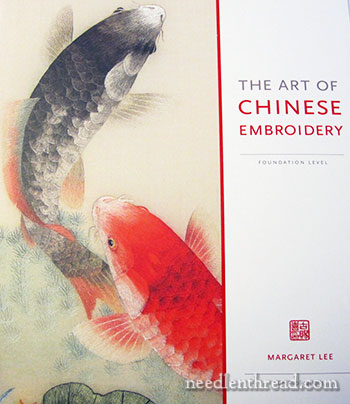
Last year, I reviewed one of Margaret Lee’s embroidery kits here on Needle ‘n Thread. At the time – and when I wrote this article on Su Embroidery – I wished for a good instructional book on the subject.
And low ‘n behold, now there is one!
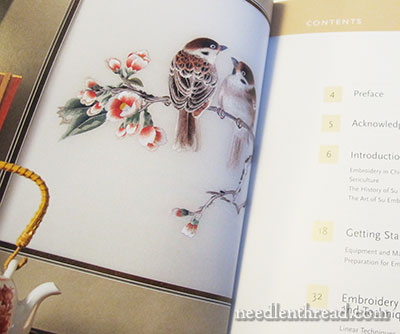
Be prepared, when you first encounter this book in person, to be completely gobsmacked by the detailed, exquisite embroidery within its pages!
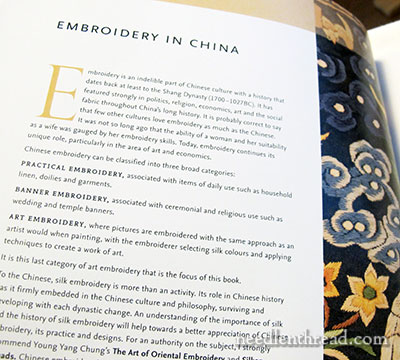
The book begins with a history of silk embroidery in China. The Chinese have been embroidering with silk at a high degree of skill for thousands of years, so it is no wonder that they have perfected the art of needle painting. (If you’re unsure of how perfect their needle painting skills are, please do look at the pictures on this article about Su embroidery. The pictures will convince you!)
The information here is brief, but it gives a good overview of the different styles of embroidery in China. From here, it moves into a more particular history of Su embroidery. And in this section, you will find some very helpful advice and some very wise words.
Margaret Lee discusses “becoming an embroidery artist.” She talks about how the embroidery artist – to become an artist – must commit to embroidery, via attitude, patience, observance, and practice.
Whether your interest is in Chinese embroidery or Western embroidery, whether your interest is in blackwork or whitework or goldwork – it doesn’t matter. If you want to become an “artist” in your area of interest, Margaret’s words are well worth reading.
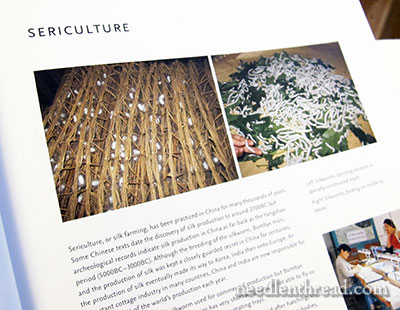
There’s also a brief bit on sericulture, the farming of silk worms, an important industry in the Far East.
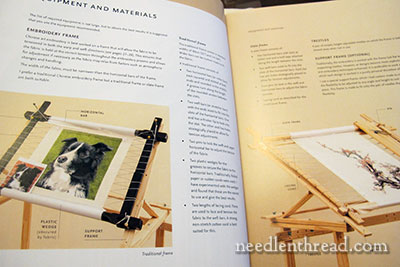
Then, as all good embroidery books do, the instructional part of the book begins with a discussion of materials. And I’ll tell you something:
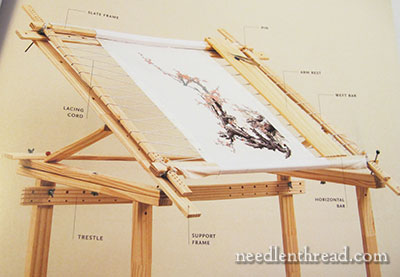
I want one of these.
This is the trestle and frame set-up. The frame is more or less a typical slate frame. The trestles are slightly different from what we normally see in Western embroidery. And I like them. I like them a lot.
The photo in the book is large and clear, so if you have a wood worker in your household (you’re a lucky duck, if you do!), you can probably have the stand whipped up in no time.
Update: These trestles and frames are available through Margaret Lee’s website.)
Besides the trim look of the trestle set up, and the wonderful slant that can be had on the work, I love the fact that Margaret Lee points out the arm rest. On traditional Western embroidery frames and trestle set-ups, the work, which sits at a much lower angle or flat, is usually covered with tissue paper or some other fabric. The arm rests on the protected fabric or the edge of the frame, if it needs to rest.
On the Chinese frame, there’s a wooden armrest that makes up part of the workstation. I may start doing that.
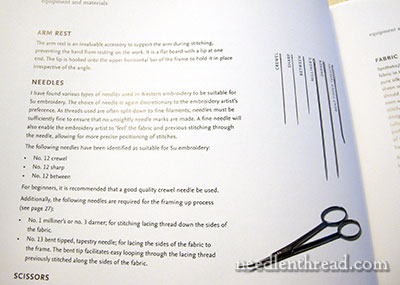
There is, of course, a section on tools, including needle requirements. When you’re working with various weights of silk on this type of detailed embroidery (and usually on silk fabric), you’ll need a variety of needles.
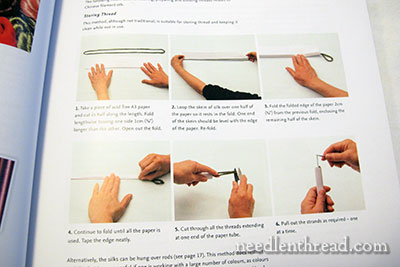
And then when get into the instructional stuff. And this is good stuff!
First up – joy, bliss! – how to handle those finicky skeins or clusters of Chinese silk! At a full-fledged workstation, the various colors of silk are usually draped and knotted over several bars near the embroiderer, so that she can easily select her colors as she stitches. Since most people don’t have a permanent workstation devoted to Chinese embroidery, Margaret Lee shows us, step-by-step, how to tame those skeins and keep them in order.
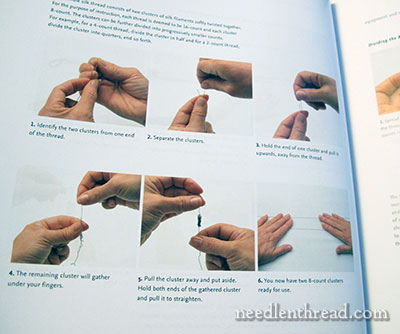
And then, there’s the whole question of separating the silk into individual strands.
If you’ve not worked with Chinese filament silk before, this information will come in so handy. It’s finicky thread, and knowing how to handle it from the outset is a real bonus. It will save you from grief and frustration!
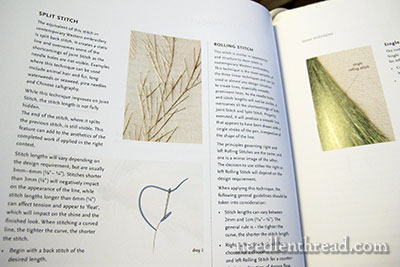
And then we move into the stitches and techniques.
At a glance, the untrained eye may look at a piece of Chinese embroidery and assume that all the stitches are the same – they all blend together so perfectly into its finished painted appearance.
But in this style of embroidery, there are actually many different stitches and variations, and Margaret Lee discusses each of them. She provides a clear diagram of how the stitch is formed, and a clear photo of the stitch in the context of a piece of embroidery.
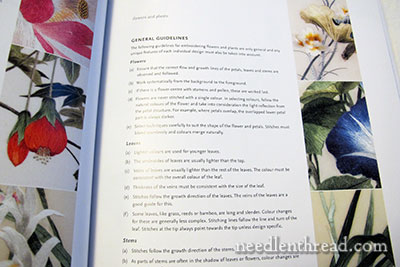
And then, we move into the projects.
The first section is about embroidering flowers and plants, and it begins with general guidelines for embroidering realistic, needle painted flowers.
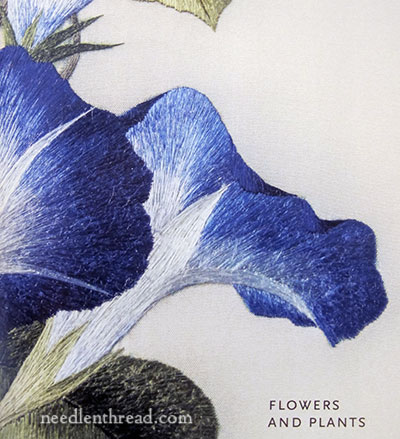
The morning glories on the cover page for this section are Glorious!
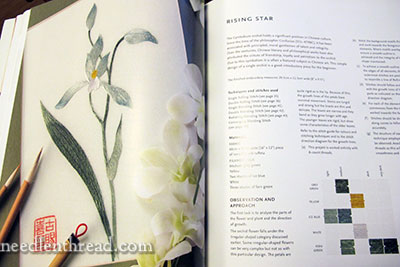
The project (or practice) section of the book is arranged into seven different projects that progress in level of experience.
In the first section on flowers and plants, there are three stunning projects.
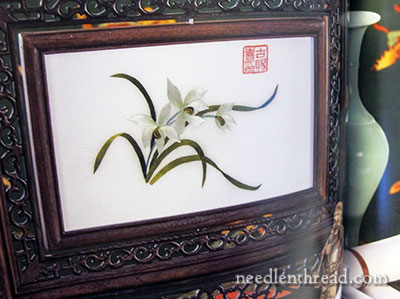
For each project, there’s a photo of the completed piece, the pattern, close up photos, a stitch guide and a color guide, and instructions on the order of stitching.
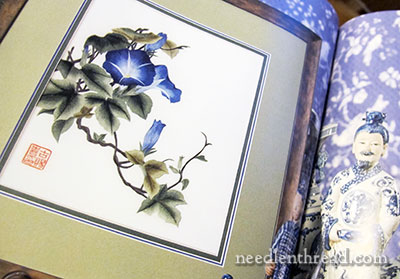
In addition to the three floral pieces, there is a project that studies the embroidering of insects, one that studies brush painting, one that explores birds, and the final project in the book is on embroidering fish (as seen on the cover of the book).
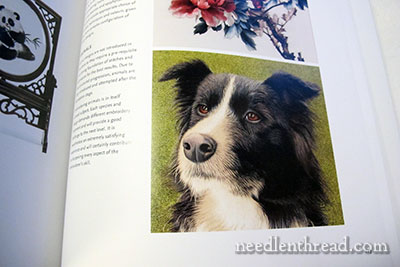
Following all the Foundation Level projects, Margaret Lee discusses what’s next. She shows us some reversible embroidery (where the front and the back create identical pictures), she discusses the embroidery of animals, and random stitch embroidery.
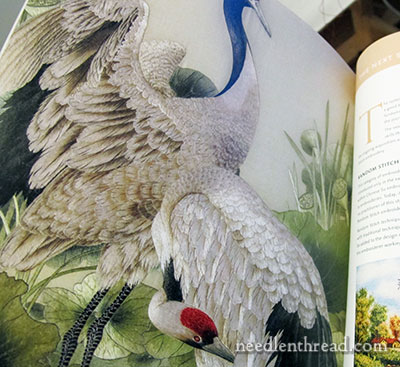
The cranes.
Oh, the cranes.
These cranes are so incredibly beautiful. You must get the book. You must see them.
For those who are under the impression that Chinese embroidery is very “flat” without any dimension or depth, these cranes will tell you a different story.
They are Sublime. The detail – the graceful movement of the neck – the perfect blending of shades and color – the play of light on the silk – every tiny detail in just the perfect place – the whole serenity of the picture. It is Art.
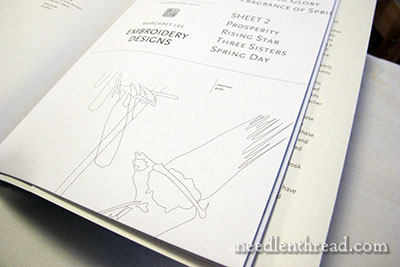
The book ends with a big section of fold out patterns, all ready for tracing.
Pros & Cons
The Art of Chinese Embroidery is a stunning, instructive, thought-provoking book.
I can only think of pros – no cons. There’s no drawback to owning this book. Even if you aren’t interested in Chinese embroidery per se, but you have an interest in the discipline of becoming an embroidery artist, or you have an interest in needle painting, in working with silk, in long and short stitch shading – in producing realistic yet beautiful embroideries – this book will speak to you.
It is instructive, gracious, and beautiful.
Where to Find
You can find The Art of Chinese Embroidery by Margaret Lee through the following book affiliates:
In the US, you can find The Art of Chinese Embroidery through Amazon.
Worldwide, with free shipping, you can find The Art of Chinese Embroidery through Book Depository.







Wow! I don’t think I could ever DO embroidery like this, but I still covet the book, just to ogle at! It does look simply stunning!
I’ve updated the article above with a link to the trestles pictured there, which are available on Margaret Lee’s website: http://www.margaretlee.com.au/store/frames–accessories/index.html
I saw that trestle stand in person!
Last year I was lucky enough to attend one of the Koala seminars, and Margaret had the stand with her when she was doing a lecture and demo on Chinese embroidery. With her permission, I took a ton of pictures and some rough measurements, planning to make one when I returned to the US.
Now they are available on the Country Bumpkin website!
I’ve asked for the book and the stand for my birthday/Christmas. Keeping my fingers crossed!
Carol S.
Oh, dear! Yes, I just found them on the CB website. I looked all over for them, with no luck! But – there they are!!
Here’s the link, for anyone looking:
http://www.countrybumpkin.com.au/product_info.php?cPath=23_91&products_id=437407
You can also find the trestle legs there, under Other Accessories:
http://www.countrybumpkin.com.au/index.php?cPath=23_91
~MC
Dear Mary
Wow this sounds so excitingly interesting that I really want to buy this, I want one of those trestles as well. I like the tools page with the needle sizes which is always useful and the instructional photographs, stitch technique and how to handle silk strands look to be very useful and informative. But the pictures Wow the cranes and the dog and the flowers absolutely beautiful and then the icing on the cake to include traceable patterns what more could you want from an embroidery book. Thanks for reviewing this wonderful book for us.
Regards Anita Simmance
Wowsers. What a terrific book. Thanks so much for sharing that, Mary.
I just found this will be available at Amazon in April 2014 and can’t be preordered but they will notify you when available. But I may not be able to wait!
Ikea sells tiltable trestles which might work: http://www.ikea.com/us/en/catalog/products/00144763/#/00225293
Lol! I love how you wax poetic about the cranes, Mary. They truly are masterful! 🙂
That book looks just the sort of thing I could spend hours enjoying, I must get a copy. I used to own an exquisite piece of antique Chinese embroidery. It was a picture of two cranes flying over a pond with lots of details of ducks, flowers, insects etc. It was stretched over a frame but unframed so I had it framed to protect it and admired the details every day when I passed it. It is difficult to explain the level of detail achieved but it was clearly master level I reluctantly sold it a few years ago as we had big life changes that needed funding but can you imagine my surprise when it reached £1,500 at the auction? I always knew the quality of the embroidery was exceptional and I like to think it was returned to China to go in a museum or collection. I spent so long looking at the details and wondering how it was done, I can still picture it in my mind’s eye and the threads were used so cleverly to depict textures and details.
You write the best reviews!! I’m fortunate to own a large pictoral Chinese embroidery that a friend gave me after his trip to China many years ago. I want to frame it but I’m not sure how to go about. The creases need to be pressed out and I’m sure it has to go under glass but not right up against the glass. What’s the best way to press out the folds . . . find someone who can do that?
Dear Caren
With a lot of our work, especially embroidery art, we do a steaming process to finish. This should get the creases out for your piece. Before you do this, You should mount it back on a frame such as the ones indicated in the book. Ensure that it aligned and stretched evenly. Steam from the back of the work- any creases or folds should disappear. We also often lightly skim the surface of the embroidery with a dry iron after steaming with a piece of acid free tissue paper(shiny/smooth surface) over the embroidery and then leave it to dry overnight. Care needs to be taken for this process. You will note that I have not mentioned it in my book for fear that it will not be correctly executed and spoil the embroidery. For my students , they learn to do this finishing process under my supervision. It helps to settle the silk threads and fabric and makes the embroidery shine even more.
Hope this helps and if you need any further information, feel free to contact me
Margaret Lee
What a wonderful book. I shall add it to my wish list.
If you have a good quality computer screen, you can see the beautiful cranes (and other work by Margaret) here:
http://www.margaretlee.com.au/gallery/chinese-embroidery/index.html
Actually, another way to get this is, I think, to buy Country Bumpkins 2014 Chinese Embroidery Calendar
http://www.countrybumpkin.com.au/product_info.php?products_id=437243
Thank you for the pre-Christmas eye candy Mary! Just to mention an alternative, the Needlemate (wooden) floor stand works well with a slate frame, Japanese frame, Lier lace frame, lace pillows & various size hoops in addition to its intended function(s) for needlepoint. It also has various height & tilt adjustments. Clearly I’m a satisfied customer! Would you please comment on how Chinese embroidery is different from Japanese? Since I already own the JEC book, what could I learn from this one? Many thanks.
Margaret Lee will also be teaching at Beating Around the Bush in 2014! More information is available on the Country Bumpkin website: http://www.countrybumpkin.com.au/webletters/batb/
Wow, Mary!! Thanks for the great review! I ordered the frame and trestles last week and it arrived yesterday! I have to be good, as I bought it for my birthday present (ahh it’s not till Feb). The book was on my wish list, but after reading your review I ordered a copy for Christmas. (My husband never knows what to get, so is happy if I buy it and he wraps it up
G’day there Mary,
Whoo hoooo! Good one Mary, and maybe especially about the stands. I’ve been keeping an eye on the book through Country Bumpkin. I’ve also been looking into the frames and stands there, on your blog and ebay etc. It gets a bit confusing when comparing different models / brands so am pleased to have your input as regard it highly, and also to be able to look into the book as you’ve shown.
Thanks, Cheers, Kath
Is taming the Chinese filaments like working with the Japanese flat silk? If so, have you tried to follow the directions from the book? For me, mastering the art of creating a stitching thread from flat silk fibers is a real challenge, so if this book gives good directions, it would be worth the price.
Waht a beautiful book…I am drooling….
I have a slightly weird question about the book–does it mention at all the use of human hair in Chinese embroidery? I’m trying to learn more about it, but I’m having trouble finding resources in English! my Google searches mostly turn up the same two articles reposted, but no academic references for me to follow up.
Margaret Lee recently gave a course in the Netherlands, and you can buy her book from the Dutch site http://www.puur-goud.nl/wetenswaardig.html (text in Dutch and English). If you are in Europe this might be preferable to buying it from Country Bumpkin. I had pre-ordered mine from Australia, and when it came I had to pay an extra 15 euro import/clearance fees.
Thank you for the awesome give away. I don’t know if I can actually do embroidery on this level but to have the book and give it a try would be awesome. The thought of even having the chance to get this awesome book is humbling. Hope your trip is fantastic. Peace,
I just pre-ordered my copy from Amazon. $33.32 with free shipping if you spend over $35 is not a bad price at all. It’s not set to be released until April though…